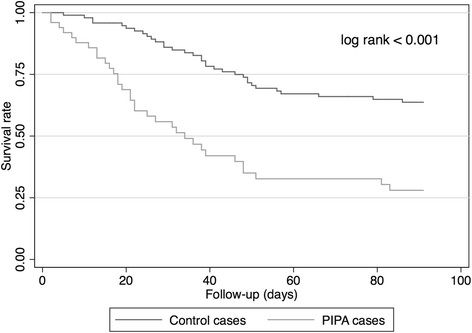Putative invasive pulmonary aspergillosis in critically ill patients with chronic obstructive pulmonary disease: a matched cohort study
- PMID: 26631029
- PMCID: PMC4668635
- DOI: 10.1186/s13054-015-1140-1
Putative invasive pulmonary aspergillosis in critically ill patients with chronic obstructive pulmonary disease: a matched cohort study
Abstract
Introduction: Patients with advanced chronic obstructive pulmonary disease (COPD) are at risk for developing invasive pulmonary aspergillosis. A clinical algorithm has been validated to discriminate colonization from putative invasive pulmonary aspergillosis (PIPA) in Aspergillus-positive respiratory tract cultures of critically ill patients. We focused on critically ill patients with COPD who met the criteria for PIPA.
Methods: This matched cohort study included critically ill patients with COPD from two university hospital intensive care units (ICUs). We studied the risk factors for PIPA as well as the impact of PIPA on short- and long-term outcomes. Whether PIPA was associated with a pattern of bacterial colonization and/or infection 6 months before and/or during ICU stay was assessed. In addition, antifungal strategies were reviewed.
Results: Fifty cases of PIPA in critically ill patients with COPD in the ICU were matched with one hundred control patients with COPD. The ICU short- and the long-term (at 1 year) mortality were significantly increased in the PIPA group (p < 0.001 for all variables). PIPA was a strong independent risk factor for mortality in the ICU (odds ratio 7.44, 95 % confidence interval 2.93-18.93, p < 0.001) before vasopressor therapy, renal replacement therapy, and duration of mechanical ventilation. Before ICU admission, the use of corticosteroids and antibiotics significantly increased the risk of PIPA (p = 0.004 and p < 0.001, respectively). No significant difference in bacterial etiologic agents responsible for colonization and/or infection was found between the groups. Antifungal treatment was started in 64 % of PIPA cases, with a poor impact on the overall outcome.
Conclusions: PIPA was a strong death predictor in critically ill patients with COPD. The use of corticosteroids and antibiotics before ICU admission was a risk factor for PIPA. PIPA was not associated with a specific bacterial pattern of colonization or infection. Prompting antifungal treatment in critically ill patients with COPD who have PIPA may not be the only factor involved in prognosis reversal.
Figures


References
-
- De Pauw B, Walsh TJ, Donnelly JP, Stevens DA, Edwards JE, Calandra T, et al. Revised definitions of invasive fungal disease from the European Organization for Research and Treatment of Cancer/Invasive Fungal Infections Cooperative Group and the National Institute of Allergy and Infectious Diseases Mycoses Study Group (EORTC/MSG) Consensus Group. Clin Infect Dis. 2008;46:1813–21. doi: 10.1086/588660. - DOI - PMC - PubMed
MeSH terms
Substances
LinkOut - more resources
Full Text Sources
Other Literature Sources
Medical
Miscellaneous

